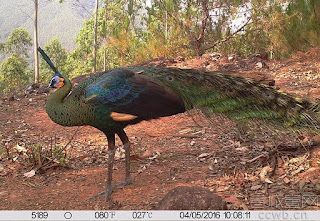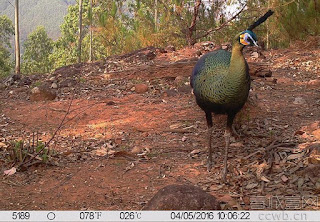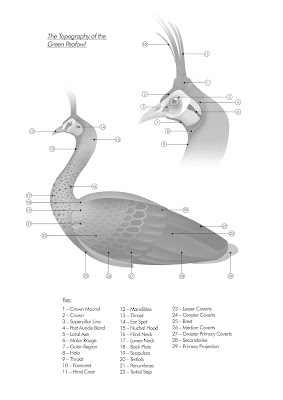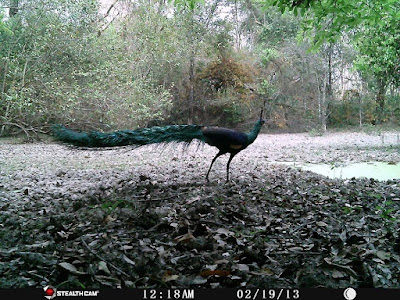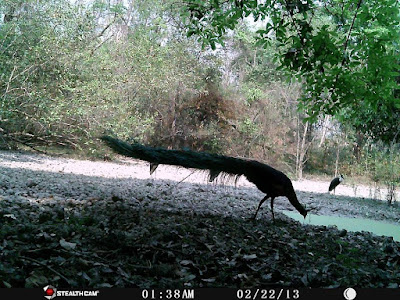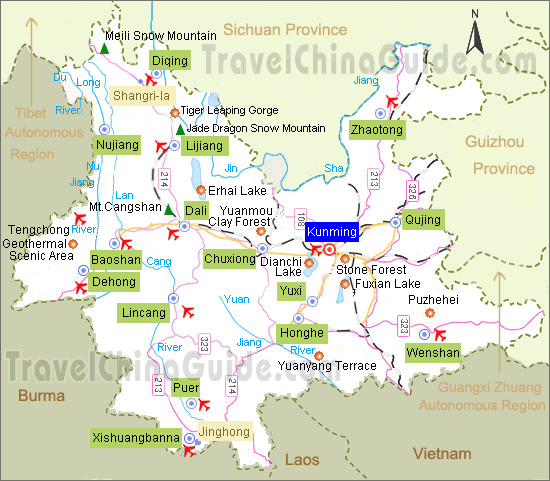All photos here appear courtesy of the Puer Forestry Bureau.

Article and Videos:http://www.ccwb.cn/mobilenews/20160415174549XLYQMR.html
Here is a translation of an article posted on the Spring City Evening News in Yunnan:
"This year, we successfully filmed not only a wild Green Peafowl, but also displaying...", Pu'er City Forestry Bureau staff member Zhou Zhi-Tao told reporters of the Spring City Evening News on April. 15. This may be the first recording of the courtship of the nationally-protected Green Peafowl, which is invaluable to the study of this species.
Zhou Zhi-Tao is the Division Deputy Chief of the Pu'Er Forestry Bureau's Wildlife Conservation and Nature Reserve department , and has dealt with wild animals and plants for many years. He said photographing Green Peafowl is far more difficult than Asian Elephants or Gibbons.
"We spent the 20 years finding and photographing Green Peafowl." Zhouzhi Tao said wild green peafowl in China found only in western Yunnan, central and southern. According to a 1991-1993 survey, the number of large Green Peafowl populations were in Jinggu, Mojiang, Ruili, Longchuan, Xinping, South China and other places, while in the past there have been local distribution records where they can no longer be seen.
"In early March this year, with our staff of the Pu'er City Forestry Bureau, at a distance for the first time to take the green peacock place about two kilometers of the place of the five cameras, camera to camera, the video is set to 30 seconds, half a month check. "Zhouzhi Tao introduction.
On March 28, a staff member checked the cameras, and found a roadside camera filmed a peacock of two meters in length.
"Compared with the peahen, peacock's tail is longer and more beautiful." pointing to the computer in the picture, Zhou Zhi-Tao said, a total of three photographs were taken of an adult male Green Peafowl. Compared with peacock blue peacock green, the most obvious difference is the neck feathers, green peacock body feathers turquoise green and blue peacock blue even more. In addition, the Yunnan local green peacock bird, blue peacock Southeast Asia introduced exotic birds.
Thereafter was another new discovery. From a camera mounted at the hilltop, a Green Peafowl was filmed
From April 1, two separate were filmed at 9:08 and 9:53, in which the first video, a displaying Green Peacock appears on the right side of the screen, rotating in place nearly 360 degrees, called a sound similar to a cat; in the second video, the peacock repeatedly raised its head to look at its surroundings.
At 10:06 on April 5 and 10:08, a male Green Peafowl was filmed twice, when it was foraging.
Zhou speculated that the four video shot in April show the same bird, but it is difficult to determine if it is the same bird filmed earlier on the roadside, as the distance between the two sites is 500 meters. From the current investigations and image data analysis, Pu'er wild green peacocks exist. "Green Peacock photographed this area, workers have seen five individuals fly to a ditch to drink; through call analysis, there should be over ten individuals." Green Peacock usually start their courtship period from March to May, after which eggs are laid, until September to October, young are hatched and raised by the mother, villagers will see often see Green Peafowl in these two periods.
According to data gathered during this visit, the Green Peafowl of Pu'Er live at an elevation of 1000 to 1800 m, mainly in tropical and subtropical evergreen broadleaf and mixed forests, especially like in the savanna, jungle and river banks, or open areas on the edge of the forest where they are active in the morning and afternoon. They like to eat peas, rice and some small insects.
"In addition to the confirmed presence of Green Peafowl photographed in Jinggu, we will examine Jingdong, Zhenyuan, and Mojiang where there is a high probability that wild Green Peafowl are present." Zhou said that for the further directions, in addition to protection and increased awareness of the Green Peafowl, they also will carry out further studies to understand more about the biology of the Green Peafowl.
Additional Notes (these reflect my own views and not those of the article itself)



